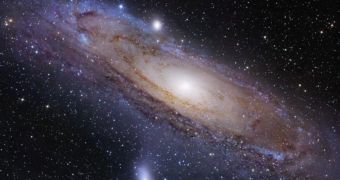The full moon lunar phase has passed, thus it's time to go back to watching the night sky, to observe some of the most amazing objects in the universe. The Andromeda galaxy, or M31 as it is also known, the closest galaxy to our Milky Way, will pass directly over our heads this week, every day between 7:30 and 8 pm.
It was first described by the Persian astronomer Abd-al-Rahman Al-Sufi in 964 in his Book of Fixed Stars, but it might have been well known to the astronomers at Isfahan ever since 905, or even earlier. Though it is clearly visible on the night sky, even with the naked eye, the "little cloud" needs perfect observation conditions such as clear sky or the absence of street or house lighting in the close vicinity, which would alter the contrast. Seen without professional tools, it would appear like a diffuse cloud of light that stretches in the sky to a width two or three times that of the moon.
With the help of a pair of binoculars, you would be able to find it in the constellation of Pegasus, in the so-called the Great Square, by focusing on the Alpheratz star then slowly shifting towards the left corner of the square, then across to the left, to the Mirach star in your sight, and finally to Andromeda. The galaxy will become more and more visible as you continue to look up in the same general direction to see the diffuse cloud of light that we know today as the Andromeda Galaxy.
If you are still unable to spot it, then you will have better chance to find it by locating the most recognizable pattern of stars on the night sky, the "W" star formation in the Cassiopeia and the Great Square of Pegasus. M31 lies right between the two.
Don't get too excited though, as a pair of binoculars or a telescope, would not give you more than a blur image of the galaxy, shaped in the form of a smooth oval, that looks brighter and brighter as you shift towards the galactic nuclei. The Andromeda appears in an oval shape due to its tilt related to our position, but it's actually circular in shape.
The M31 name comes from the Charles Messier catalog, which lists it under the name of Messier 31, and as our own galaxy, it's formed of an accumulation of a few hundred billion stars. It was first cataloged as a nebulae resembling a hazy comet, but was later proven to be a galaxy, one of the most distant structures in the universe that we can see with the naked eye.
From astronomical observations, it seems that Andromeda is slightly larger than our galaxy, having a diameter of nearly 200,000 light years, equivalent to about one and a half times that of the Milky Way, and as many other large spiral galaxies it has a number of small satellite galaxies.
As you're watching the Andromeda, due to the fact that light does not travel instantaneously, you are actually seeing an object in a distant past, about 2.5 million years back. So the image you are looking at is from a time when humans were only in the dawn of their conscious thinking, about 480 years older than the Pyramids built by the Egyptians. We cannot even comprehend the distance the light has traveled in this time, estimated at about 24 quintillion kilometers, meaning 24 followed by 18 zeros.
Though the galaxy was clearly visible with 184 centimeter telescopes such as Lord Rosse's, at Birr Castle in the middle of the 19th century, it wasn't until the 1923 that it was cataloged as a galaxy by Edwin Hubble who observed it with a 256 centimeter telescope at Mount Wilson Observatory.

 14 DAY TRIAL //
14 DAY TRIAL //